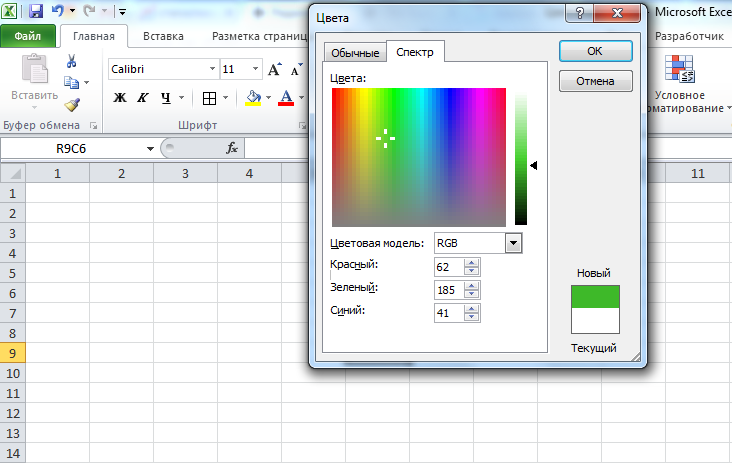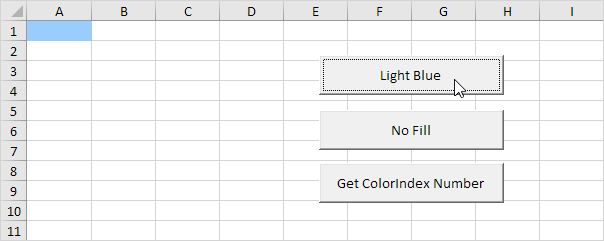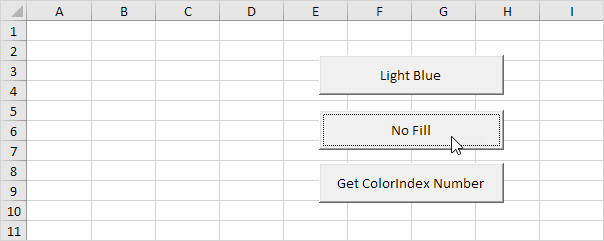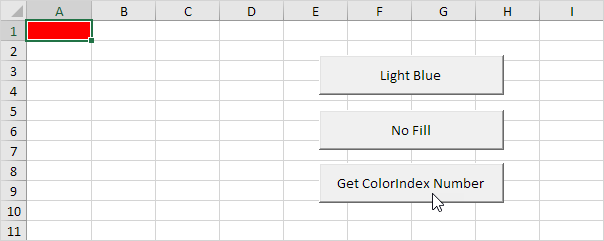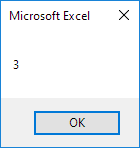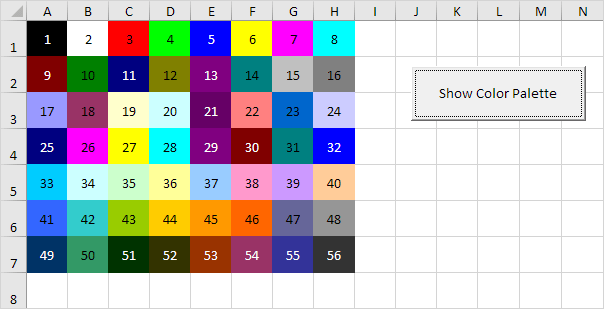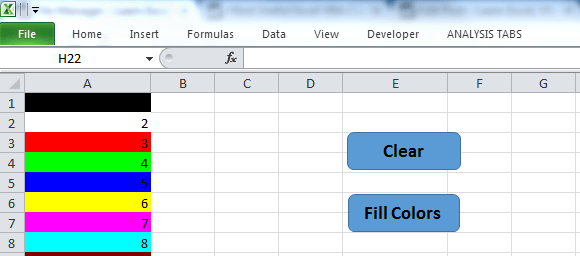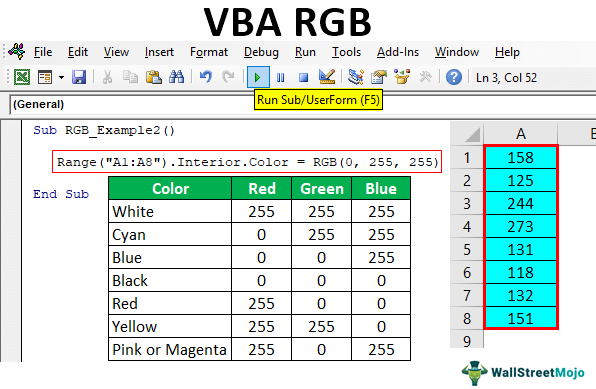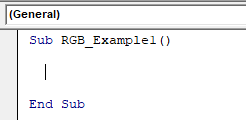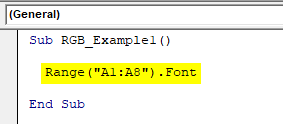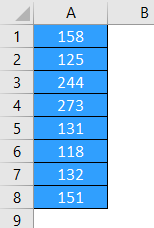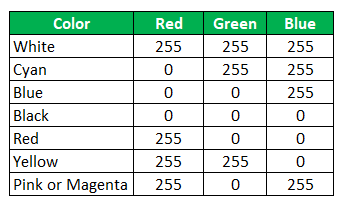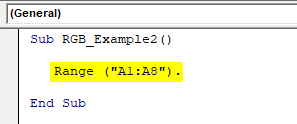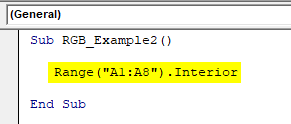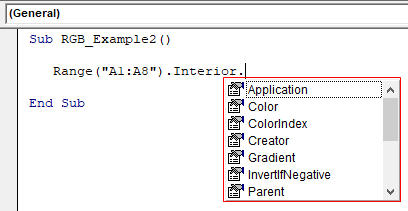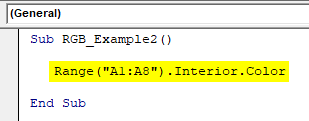Заливка ячейки цветом в VBA Excel. Фон ячейки. Свойства .Interior.Color и .Interior.ColorIndex. Цветовая модель RGB. Стандартная палитра. Очистка фона ячейки.
Свойство .Interior.Color объекта Range
Начиная с Excel 2007 основным способом заливки диапазона или отдельной ячейки цветом (зарисовки, добавления, изменения фона) является использование свойства .Interior.Color объекта Range путем присваивания ему значения цвета в виде десятичного числа от 0 до 16777215 (всего 16777216 цветов).
Заливка ячейки цветом в VBA Excel
Пример кода 1:
|
Sub ColorTest1() Range(«A1»).Interior.Color = 31569 Range(«A4:D8»).Interior.Color = 4569325 Range(«C12:D17»).Cells(4).Interior.Color = 568569 Cells(3, 6).Interior.Color = 12659 End Sub |
Поместите пример кода в свой программный модуль и нажмите кнопку на панели инструментов «Run Sub» или на клавиатуре «F5», курсор должен быть внутри выполняемой программы. На активном листе Excel ячейки и диапазон, выбранные в коде, окрасятся в соответствующие цвета.
Есть один интересный нюанс: если присвоить свойству .Interior.Color отрицательное значение от -16777215 до -1, то цвет будет соответствовать значению, равному сумме максимального значения палитры (16777215) и присвоенного отрицательного значения. Например, заливка всех трех ячеек после выполнения следующего кода будет одинакова:
|
Sub ColorTest11() Cells(1, 1).Interior.Color = —12207890 Cells(2, 1).Interior.Color = 16777215 + (—12207890) Cells(3, 1).Interior.Color = 4569325 End Sub |
Проверено в Excel 2016.
Вывод сообщений о числовых значениях цветов
Числовые значения цветов запомнить невозможно, поэтому часто возникает вопрос о том, как узнать числовое значение фона ячейки. Следующий код VBA Excel выводит сообщения о числовых значениях присвоенных ранее цветов.
Пример кода 2:
|
Sub ColorTest2() MsgBox Range(«A1»).Interior.Color MsgBox Range(«A4:D8»).Interior.Color MsgBox Range(«C12:D17»).Cells(4).Interior.Color MsgBox Cells(3, 6).Interior.Color End Sub |
Вместо вывода сообщений можно присвоить числовые значения цветов переменным, объявив их как Long.
Использование предопределенных констант
В VBA Excel есть предопределенные константы часто используемых цветов для заливки ячеек:
| Предопределенная константа | Наименование цвета |
|---|---|
| vbBlack | Черный |
| vbBlue | Голубой |
| vbCyan | Бирюзовый |
| vbGreen | Зеленый |
| vbMagenta | Пурпурный |
| vbRed | Красный |
| vbWhite | Белый |
| vbYellow | Желтый |
| xlNone | Нет заливки |
Присваивается цвет ячейке предопределенной константой в VBA Excel точно так же, как и числовым значением:
Пример кода 3:
|
Range(«A1»).Interior.Color = vbGreen |
Цветовая модель RGB
Цветовая система RGB представляет собой комбинацию различных по интенсивности основных трех цветов: красного, зеленого и синего. Они могут принимать значения от 0 до 255. Если все значения равны 0 — это черный цвет, если все значения равны 255 — это белый цвет.
Выбрать цвет и узнать его значения RGB можно с помощью палитры Excel:
Палитра Excel
Чтобы можно было присвоить ячейке или диапазону цвет с помощью значений RGB, их необходимо перевести в десятичное число, обозначающее цвет. Для этого существует функция VBA Excel, которая так и называется — RGB.
Пример кода 4:
|
Range(«A1»).Interior.Color = RGB(100, 150, 200) |
Список стандартных цветов с RGB-кодами смотрите в статье: HTML. Коды и названия цветов.
Очистка ячейки (диапазона) от заливки
Для очистки ячейки (диапазона) от заливки используется константа xlNone:
|
Range(«A1»).Interior.Color = xlNone |
Свойство .Interior.ColorIndex объекта Range
До появления Excel 2007 существовала только ограниченная палитра для заливки ячеек фоном, состоявшая из 56 цветов, которая сохранилась и в настоящее время. Каждому цвету в этой палитре присвоен индекс от 1 до 56. Присвоить цвет ячейке по индексу или вывести сообщение о нем можно с помощью свойства .Interior.ColorIndex:
Пример кода 5:
|
Range(«A1»).Interior.ColorIndex = 8 MsgBox Range(«A1»).Interior.ColorIndex |
Просмотреть ограниченную палитру для заливки ячеек фоном можно, запустив в VBA Excel простейший макрос:
Пример кода 6:
|
Sub ColorIndex() Dim i As Byte For i = 1 To 56 Cells(i, 1).Interior.ColorIndex = i Next End Sub |
Номера строк активного листа от 1 до 56 будут соответствовать индексу цвета, а ячейка в первом столбце будет залита соответствующим индексу фоном.
Подробнее о стандартной палитре Excel смотрите в статье: Стандартная палитра из 56 цветов, а также о том, как добавить узор в ячейку.
As part of a VBA program, I have to set the background colors of certain cells to green, yellow or red, based on their values (basically a health monitor where green is okay, yellow is borderline and red is dangerous).
I know how to set the values of those cells, but how do I set the background color.
asked Dec 13, 2008 at 11:39
paxdiablopaxdiablo
844k233 gold badges1565 silver badges1937 bronze badges
You can use either:
ActiveCell.Interior.ColorIndex = 28
or
ActiveCell.Interior.Color = RGB(255,0,0)
answered Dec 13, 2008 at 11:43
Vinko Vrsalovic♦Vinko Vrsalovic
328k53 gold badges332 silver badges370 bronze badges
2
This is a perfect example of where you should use the macro recorder. Turn on the recorder and set the color of the cells through the UI. Stop the recorder and review the macro. It will generate a bunch of extraneous code, but it will also show you syntax that works for what you are trying to accomplish. Strip out what you don’t need and modify (if you need to) what’s left.
answered Apr 18, 2012 at 2:34
Jon CrowellJon Crowell
21.5k14 gold badges88 silver badges110 bronze badges
Do a quick ‘record macro’ to see the color number associated with the color you’re looking for (yellow highlight is 65535). Then erase the code and put
Sub Name()
Selection.Interior.Color = 65535 '(your number may be different depending on the above)
End Sub
answered Mar 4, 2020 at 15:07
1
or alternatively you could not bother coding for it and use the ‘conditional formatting’ function in Excel which will set the background colour and font colour based on cell value.
There are only two variables here so set the default to yellow and then overwrite when the value is greater than or less than your threshold values.
answered Dec 30, 2008 at 12:34
It doesn’t work if you use Function, but works if you Sub. However, you cannot call a sub from a cell using formula.
answered Mar 22, 2015 at 18:08
0
Changing background colors in Excel VBA is easy. Use the Interior property to return an Interior object. Then use the ColorIndex property of the Interior object to set the background color of a cell.
Place three command buttons on your worksheet and add the following code lines:
1. The code line below sets the background color of cell A1 to light blue.
Range(«A1»).Interior.ColorIndex = 37
Result:
2. The following code line sets the background color of cell A1 to ‘No Fill’.
Range(«A1»).Interior.ColorIndex = 0
Result:
3. If you want to know the ColorIndex number of a color, simply ask Excel VBA.
MsgBox Selection.Interior.ColorIndex
Select cell A1 and click the command button on the sheet:
Result:
4. The ColorIndex property gives access to a color palette of 56 colors.
Note: download the Excel file to see how we created this color palette.
5. If you can’t find the specific color you are looking for, use the Color property and the RGB function.
Range(«A1»).Interior.Color = RGB(255, 0, 0)
Explanation: RGB stands for Red, Green and Blue. These are the three primary colors. Each component can take on a value from 0 to 255. With this function you can make every color. RGB(255,0,0) gives the pure Red color (ColorIndex = 3 produces the exact same result).
Change Background Color of Cell Range in Excel VBA
Description:
It is an interesting feature in excel, we can change background color of Cell, Range in Excel VBA. Specially, while preparing reports or dashboards, we change the backgrounds to make it clean and get the professional look to our projects.
Change Background Color of Cell Range in Excel VBA – Solution(s):
We can use Interior.Color OR Interior.ColorIndex properties of a Rage/Cell to change the background colors.
Change Background Color of Cell Range in Excel VBA – Examples
The following examples will show you how to change the background or interior color in Excel using VBA.
Example 1
In this Example below I am changing the Range B3 Background Color using Cell Object
Sub sbRangeFillColorExample1() 'Using Cell Object Cells(3, 2).Interior.ColorIndex = 5 ' 5 indicates Blue Color End Sub
Example 2
In this Example below I am changing the Range B3 Background Color using Range Object
Sub sbRangeFillColorExample2()
'Using Range Object
Range("B3").Interior.ColorIndex = 5
End Sub
Example 3
We can also use RGB color format, instead of ColorIndex. See the following example:
Sub sbRangeFillColorExample3()
'Using Cell Object
Cells(3, 2).Interior.Color = RGB(0, 0, 250)
'Using Range Object
Range("B3").Interior.Color = RGB(0, 0, 250)
End Sub
Example 4
The following example will apply all the colorIndex form 1 to 55 in Activesheet.
Sub sbPrintColorIndexColors()
Dim iCntr
For iCntr = 1 To 56
Cells(iCntr, 1).Interior.ColorIndex = iCntr
Cells(iCntr, 1) = iCntr
Next iCntr
End Sub
Instructions:
- Open an excel workbook
- Press Alt+F11 to open VBA Editor
- Insert a new module from Insert menu
- Copy the above code and Paste in the code window
- Save the file as macro enabled workbook
- Press F5 to execute the procedure
- You can see the interior colors are changing as per our code
Change Background Color of Cell Range in Excel VBA – Download: Example File
Here is the sample screen-shot of the example file.
Download the file and explore how to change the interior or background colors in Excel using VBA.
ANALYSIS TABS – ColorIndex
A Powerful & Multi-purpose Templates for project management. Now seamlessly manage your projects, tasks, meetings, presentations, teams, customers, stakeholders and time. This page describes all the amazing new features and options that come with our premium templates.
Save Up to 85% LIMITED TIME OFFER

All-in-One Pack
120+ Project Management Templates
Essential Pack
50+ Project Management Templates
Excel Pack
50+ Excel PM Templates
PowerPoint Pack
50+ Excel PM Templates
MS Word Pack
25+ Word PM Templates
Ultimate Project Management Template
Ultimate Resource Management Template
Project Portfolio Management Templates
Related Posts
VBA Reference
Effortlessly
Manage Your Projects
120+ Project Management Templates
Seamlessly manage your projects with our powerful & multi-purpose templates for project management.
120+ PM Templates Includes:
3 Comments
-
Harbinder Singh
April 13, 2017 at 12:23 PM — Replyneed help in excel
In company there are 10000 employee and all having duty in A shift, B shift, C shift. Each shift of 08 hrs
i have to find those employee who work continuous 10 days or more then 10 days
please help me to find the solution using VB macro in excel or any other way to find from huge no of data in excel
Kindly provide me the solution.
-
RandomOne
May 23, 2017 at 5:46 AM — ReplyHarbinder Singh
its dependes of your database, can check with a vba code for filter based on the criteria, select the range and then color it,
Regards! -
Ken Schleede
July 10, 2019 at 6:44 AM — ReplyThanks! This is excellent. It allows me to control the colors much more reliably than conditional formatting.
Effectively Manage Your
Projects and Resources
ANALYSISTABS.COM provides free and premium project management tools, templates and dashboards for effectively managing the projects and analyzing the data.
We’re a crew of professionals expertise in Excel VBA, Business Analysis, Project Management. We’re Sharing our map to Project success with innovative tools, templates, tutorials and tips.
Project Management
Excel VBA
Download Free Excel 2007, 2010, 2013 Add-in for Creating Innovative Dashboards, Tools for Data Mining, Analysis, Visualization. Learn VBA for MS Excel, Word, PowerPoint, Access, Outlook to develop applications for retail, insurance, banking, finance, telecom, healthcare domains.
Page load link
Go to Top
Return to VBA Code Examples
This tutorial will demonstrate how to change a cell’s background color using VBA.
Change Cell Background Color with Interior.colorindex
To change a cell’s background color using VBA you can use the Interior.Colorindex property. Here’s a couple ways to change the background color of cell A1.
An example using the Range() method:
Range("A1").Interior.ColorIndex = 5An example using the Cells() method:
Cells(1, 1).Interior.ColorIndex = 15Need an easy way to determine what number equals what color? Check out Color Reference For Colorindex.

VBA Code Examples Add-in
Easily access all of the code examples found on our site.
Simply navigate to the menu, click, and the code will be inserted directly into your module. .xlam add-in.
(No installation required!)
Free Download
Change the Background Colors in Excel VBA is an easy task.
In this blog post, you will learn about changing the background colors in Excel VBA.
In Excel, we change the background color by selecting the range, then go to the ‘Home’ tab then go to the ‘Font’ group and select the ‘Fill Color’ option.
Click the drop-down link and there are multiple colors, which you can apply into your selected range where you want to change the background color.
Here, you will learn about how to change the background colors with the help of VBA.
In VBA, you will learn to change the background color with three (3) easiest methods.
In this method, you can use 8 standard colors in the VBA. These color are as follows:-
Black – vbBlack
White – vbWhite
Red -vbRed
Blue – vbBlue
Green – vbGreen
Yellow – vbYellow
Cyan – vbCyan
Magenta – vbMagenta
These are 8 standard colors, which we can apply with their names in VBA.
Change the Background Colors in Excel VBA, we need to use the above standard colors in VBA Code.
Now, we will apply these codes in one of our VBA macros to change the colors of background colors in Excel VBA within cells from range “A1” to “A10”.
Range(“A1:A10”).Interior.Color = vbBlack
Range(“A1:A10”).Interior.Color = vbWhite
Range(“A1:A10”).Interior.Color = vbRed
Range(“A1:A10”).Interior.Color = vbBlue
Range(“A1:A10”).Interior.Color = vbGreen
Range(“A1:A10”).Interior.Color = vbYellow
Range(“A1:A10”).Interior.Color = vbCyan
Range(“A1:A10”).Interior.Color = vbMagenta
End Sub
By executing the above VBA code by pressing “F8” step by step, our result will be shown as the below image:-

If you execute the above code by pressing “F8”, you will notice each execution will change the background colors.
Below is the another method to “Change the Background Colors in Excel VBA”.
Change the Background Colors – Using ColorIndex Method
In this method, there are 56 colors that we can apply to ‘change our background colors in Excel VBA,.
Each number from 1 to 56 has a particular color code.
When we will apply this method to change the background color, we will change the code ‘ColorIndex’ in place of ‘Color’.
Now we will apply for these numbers in the VBA editor window to change the background colors.
See the code in the VBA editor window:-
Range(“A1:A10”).Interior.ColorIndex = 1
Range(“A1:A10”).Interior.ColorIndex = 2
Range(“A1:A10”).Interior.ColorIndex = 5
Range(“A1:A10”).Interior.ColorIndex = 15
Range(“A1:A10”).Interior.ColorIndex = 25
Range(“A1:A10”).Interior.ColorIndex = 45
Range(“A1:A10”).Interior.ColorIndex = 55
Range(“A1:A10”).Interior.ColorIndex = 56
End Sub
Now we will execute the above code by pressing “F8” again and again to execute each of the codes.
See below image for result:-

Here we have only applied some code to change the background colors in Excel VBA.
But, in this method, we can use the number from 1 to 56 to apply different colors.
Changing background color by RGB (Red, Green, Blue) Method
RGB is a short form of Red, Green, and Blue.
These are the basic or primary colors and by combining these colors we can create multiple other new colors.
This is our 3rd method to ‘change the background colors in Excel VBA.
When applying these colors in VBA can be written as RGB (255,255,255).
Values in the bracket are the color code of each color, where the range of each color from 0 to 255. Where “0” is the minimum and “255” is the maximum range.
We can create multiples of colors with the help of these three (3) color codes.
Between ranges we can put any number for any color combination.
See the VBA code in the VBA Editor window:-
Range(“A1:A10”).Interior.Color = RGB(0, 0, 0)
‘for Black Color
Range(“A1:A10”).Interior.Color = RGB(0, 0, 255)
‘for Blue Color
Range(“A1:A10”).Interior.Color = RGB(0, 255, 0)
‘ For green Color
Range(“A1:A10”).Interior.Color = RGB(0, 255, 255)
‘For Cyan Color
Range(“A1:A10”).Interior.Color = RGB(255, 0, 0)
‘For Red Color
Range(“A1:A10”).Interior.Color = RGB(255, 0, 255)
‘For Magenta Color
Range(“A1:A10”).Interior.Color = RGB(255, 255, 0)
‘For Yellow Color
End Sub
Now pressing “F8” to execute the above code step by step, we will get the following result.
See the image below:-

Here, you can see that how we change the background colors in Excel VBA by the RGB method.
Here, in this post, we have explained the 3 easiest methods to change the background colors in Excel VBA.
Furthermore, details for the Excel Interior Color (Background Color) are provided on the Microsoft Office website.
I hope you find this post useful.
Please feel free to put your comments or suggestion.
Thanks
Related Post
Copy and Paste in Excel VBA: 4 Easiest Way
Excel VBA RGB Color
RGB can also be called red, green, and blue. So, one may use this function to get the numerical value of the color value. This function has three components as a named range, and they are red, blue, and green. The other colors are the components of these three different colors in VBA.
In VBA, everything boils down to the coding of every piece. For example, we can use the RANGE object if you want to reference some portion of the worksheet. If you want to change the font color, we can use the NAME property of the range. Then, write the font name that we need but imagine a situation of changing the font color or the cell’s background color. Of course, we can use built-in VB colors like vbGreen, vbBlue, vbRed, etc. But, we have a dedicated function to play around with different colors, i.e., RGB.
Table of contents
- Excel VBA RGB Color
- Change Color of Cells using VBA RGB Function
- Example #1
- Example #2
- Things to Remember Here
- Recommended Articles
- Change Color of Cells using VBA RGB Function
Below is the syntax of the RGB color function.
As you can see above, we can supply three arguments: red, green, and blue. These three parameters can only accept integer numbers ranging from 0 to 255. The result of this function will be the “Long” data type.
Change Color of Cells using VBA RGB Function
You can download this VBA RGB Excel Template here – VBA RGB Excel Template
Example #1
We have numbers from cells A1 to A8, as shown in the below image.
We will try to change the font color to some random color for this range of cells by using the RGB function.
Start the macro procedure first.
Code:
Sub RGB_Example1() End Sub
First, we need to reference the range of cells of fonts we want to change the color of. In this case, our range of cells is A1 to A8, so supply the same using the RANGE object.
Code:
Sub RGB_Example1() Range ("A1:A8") End Sub
Put a dot to see the IntelliSense list of RANGE objects. From the IntelliSense list, we are trying to change the font color, so choose the FONT property from the list.
Code:
Sub RGB_Example1() Range("A1:A8").Font End Sub
Once we chose the FONT property in this property, we tried to change the color, so we chose the color property of the FONT.
Code:
Sub RGB_Example1() Range("A1:A8").Font.Color End Sub
Put an equal sign and open the RGB function.
Code:
Sub RGB_Example1() Range("A1:A8").Font.Color = RGB( End Sub
Give random integer numbers ranging from 0 to 255 for all three arguments of the RGB function.
Code:
Sub RGB_Example1() Range("A1:A8").Font.Color = RGB(300, 300, 300) End Sub
Now, run the code and see the result of font colors of the cells from A1 to A8.
Output:
So, the colors of the font changed from black to some other. The color depends on the numbers we give to the RGB function.
Below are RGB color codes to get some of the common colors.
You can just change the integer number combination from 0 to 255 to get the different sorts of colors.
Example #2
For the same range of cells, let us see how to change the background color of these cells.
First, supply the range of cells by using the RANGE object.
Code:
Sub RGB_Example2() Range ("A1:A8"). End Sub
This time we are changing the background color of the mentioned cells, so we have nothing to do with the FONT property. Now, choose the “Interior” property of the RANGE object to change the background color.
Code:
Sub RGB_Example2() Range("A1:A8").Interior End Sub
Once the “Interior” property is selected, a dot to see the properties and methods of this “Interior” property.
Code:
Sub RGB_Example2() Range("A1:A8").Interior. End Sub
Since we are changing the interior color of the mentioned cells, choose the “Color” property.
Code:
Sub RGB_Example2() Range("A1:A8").Interior.Color End Sub
Set the interior color property of the range of cells (A1 to A8) out the equal sign and open the RGB function.
Code:
Sub RGB_Example2() Range("A1:A8").Interior.Color = RGB( End Sub
Enter the random number as you want.
Code:
Sub RGB_Example2() Range("A1:A8").Interior.Color = RGB(0, 255, 255) End Sub
Run the code and see the background color.
Output:
The background color has changed.
Things to Remember Here
- RGB stands for Red, Green, and Blue.
- A combination of these three colors will give different colors.
- All these three parameters can accept integer values between 0 to 255 only. It will reset any numbers above this to 255.
Recommended Articles
This article has been a guide to VBA RGB. Here, we discuss changing the color of the interior cell (background, font) in Excel VBA by putting different integer numbers in the RGB function with examples and a downloadable Excel template. Below are some useful Excel articles related to VBA: –
- VBA Font Color
- Excel VBA Web Scraping
- Color Index in VBA
- Class in VBA
- VBA MsgBox (Yes/No)
<<Lesson 15>> [Contents] <<Lesson 17>>
In this Lesson, we will explore how to write Excel VBA code that formats the color of an MS Excel spreadsheet. Using Excel VBA code, we can change the font color as well as the background color of each cell effortlessly.
Alright, let’s create a program that can format random font and background colors using a randomizing process. Colors can be assigned using a number of methods in Excel VBA, but it is easier to use the RGB function. The RGB function has three numbers corresponding to the red, green and blue components. The range of values of the three numbers is from 0 to 255. A mixture of the three primary colors will produce different colors.
The syntax to set the font color is
cells(i,j).Font.Color=RGB(x,y,x)
where x,y, z are any numbers between 1 and 255
The syntax to set the cell’s background color is
cells(i,j).Interior.Color=RGB(x,y,x)
Where x,y, z can be any number between 1 and 255
Some RGB Color Codes are shown in the following chart,
| Color | RGB Code |
|---|---|
| (0,0,0) | |
| (255,0,0) | |
| (255,255,0) | |
| (255,165,0) | |
| (0,0,255) | |
| (0,128,0) | |
| (128,0,128) |
Example 16.1
In this example, clicking the command button changes the background colors from Cells(1,1) to Cells(7,1) according to the specified RGB color codes. It also format the font colors from Cells(1,2) to cells(7,2) using specified RGB color codes.
The code
Private Sub CommandButton1_Click()
Dim i As Integer
‘To fill the cells with colors using RGB codes
Cells(1, 1).Interior.Color = RGB(0, 0, 0)
Cells(2, 1).Interior.Color = RGB(255, 0, 0)
Cells(3, 1).Interior.Color = RGB(255, 255, 0)
Cells(4, 1).Interior.Color = RGB(255, 165, 0)
Cells(5, 1).Interior.Color = RGB(0, 0, 255)
Cells(6, 1).Interior.Color = RGB(0, 128, 0)
Cells(7, 1).Interior.Color = RGB(128, 0, 128)
‘To format font color with RGB codes
For i = 1 To 7
Cells(i, 2).Value = “Font Color”
Next
Cells(1, 2).Font.Color = RGB(0, 0, 0)
Cells(2, 2).Font.Color = RGB(255, 0, 0)
Cells(3, 2).Font.Color = RGB(255, 255, 0)
Cells(4, 2).Font.Color = RGB(255, 165, 0)
Cells(5, 2).Font.Color = RGB(0, 0, 255)
Cells(6, 2).Font.Color = RGB(0, 128, 0)
Cells(7, 2).Font.Color = RGB(128, 0, 128)
End Sub
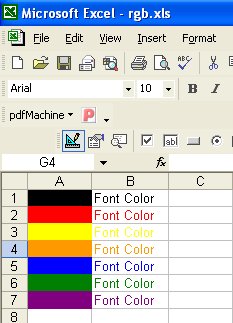
Example 16.2
In this example, the font color in cells(1,1) and background color in cells(2,1) are changing for every click of the command button due to the randomized process.Rnd is a random number between 0 and 1, therefore 255* Rnd will produce a number between 0 and 255 and Int(255*Rnd) will produce integers that take the values from 0 to 254
So we need to add 1 to get random integers from 0 to 255.
For example;Rnd=0.229
255*Rnd=58.395
Int(58.395)=58
The code
Private Sub CommandButton1_Click()Randomize Timer
Dim i, j, k As Integer
i = Int(255 * Rnd) + 1
j = Int(255 * Rnd) + 1
k = Int(255 * Rnd) + 1
Cells(1, 1).Font.Color = RGB(i, j, k)
Cells(2, 1).Interior.Color = RGB(j, k, i)
End Sub
The Output
<<Lesson 15>> [Contents] <<Lesson 17>>

